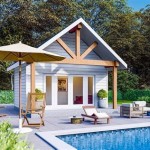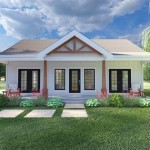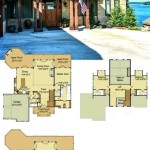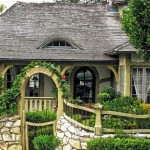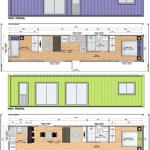A multi-generational house plan is a type of housing designed to accommodate multiple generations of a family under one roof. These plans typically feature separate living spaces for each generation, as well as shared common areas. Multi-generational homes are becoming increasingly popular as more and more families choose to live together for financial, emotional, and practical reasons.
One of the most common reasons for choosing a multi-generational house plan is to save money. By sharing a home, families can reduce their housing costs, utility bills, and other expenses. Multi-generational homes can also be a great way to provide care for elderly family members or children. With multiple generations living together, there is always someone available to help with daily tasks, errands, and other needs.
Apart from the financial and practical benefits, multi-generational homes also offer a number of social and emotional benefits. Living together allows families to spend more time with each other, strengthen their bonds, and create lasting memories. It also provides children with the opportunity to learn from their grandparents and other older family members, while seniors can benefit from the energy and vitality of the younger generation.
Multi-generational house plans offer a number of advantages, including:
- Reduced housing costs
- Shared expenses
- Care for elderly family members
- Childcare support
- Stronger family bonds
- Preservation of family history
- Increased sense of community
- Reduced environmental impact
- Enhanced quality of life
Multi-generational house plans are a great option for families who want to live together, save money, and create lasting memories.
Reduced housing costs
One of the biggest advantages of a multi-generational house plan is the potential to save money on housing costs. By sharing a home, families can reduce their housing expenses in a number of ways.
First, families can save on the cost of purchasing a home. When multiple generations live together, they can pool their resources to buy a larger home than they could afford on their own. This can be especially beneficial for families with elderly members who need more space or families with children who need a yard to play in.
Second, families can save on monthly housing costs. When multiple generations live together, they can share the cost of utilities, property taxes, and insurance. This can add up to significant savings over time.
Third, families can save on the cost of maintenance and repairs. When multiple generations live together, they can share the responsibility for maintaining the home. This can help to reduce the cost of repairs and keep the home in good condition.
Overall, a multi-generational house plan can be a great way to save money on housing costs. By sharing a home, families can reduce their expenses and free up more money for other things.
Shared expenses
In addition to saving on housing costs, multi-generational house plans can also help families save money on other expenses. When multiple generations live together, they can share the cost of a number of household expenses, including:
- Utilities: Families can save money on utilities by sharing the cost of electricity, gas, water, and trash removal.
- Groceries: Families can save money on groceries by buying in bulk and cooking meals together.
- Transportation: Families can save money on transportation by sharing cars and using public transportation.
- Childcare: Families can save money on childcare by sharing the responsibility of caring for children.
- Education: Families can save money on education by sharing the cost of private schools or college tuition.
In addition to these direct savings, multi-generational house plans can also help families save money in other indirect ways. For example, families may be able to reduce their spending on entertainment and dining out by spending more time together at home. They may also be able to save money on healthcare costs by having access to family members who can provide care and support.
Overall, multi-generational house plans can help families save money in a number of ways. By sharing expenses and resources, families can free up more money for other things, such as education, travel, or retirement.
In addition to the financial benefits, sharing expenses can also have a number of other advantages. For example, it can help to strengthen family bonds and create a sense of community. When families share expenses, they are more likely to work together and support each other. This can lead to a stronger and more resilient family unit.
Care for elderly family members
Multi-generational house plans can be a great way to provide care for elderly family members. When multiple generations live together, there is always someone available to help with daily tasks, errands, and other needs. This can allow elderly family members to maintain their independence and quality of life while also receiving the care and support they need.
There are a number of specific ways that multi-generational house plans can benefit elderly family members. For example, multi-generational homes can provide:
- Companionship: Elderly family members who live with other generations are less likely to feel lonely or isolated. They have regular opportunities to interact with family members of all ages, which can help to improve their mood and overall well-being.
- Assistance with daily tasks: Elderly family members who need help with daily tasks, such as cooking, cleaning, or bathing, can get assistance from other family members. This can help them to maintain their independence and avoid having to move to a nursing home or assisted living facility.
- Transportation: Elderly family members who do not drive can rely on other family members to provide transportation to appointments, errands, and other activities. This can help them to stay active and engaged in the community.
- Emotional support: Elderly family members who are facing challenges, such as grief, illness, or financial difficolt, can get emotional support from other family members. This can help them to cope with difficult times and maintain a positive outlook on life.
In addition to these specific benefits, multi-generational house plans can also provide elderly family members with a sense of purpose and belonging. When they live with other generations, they feel like they are part of a larger community and that they are valued and respected.
Overall, multi-generational house plans can be a great way to provide care for elderly family members. They offer a number of benefits that can help elderly family members to maintain their independence, quality of life, and sense of well-being.
It is important to note that multi-generational house plans are not always the right choice for everyone. There may be some cases where it is not feasible or desirable for elderly family members to live with other generations. However, for families who are considering this option, there are a number of resources available to help them make the best decision for their loved ones.
Childcare support
Multi-generational house plans can be a great way to provide childcare support. When multiple generations live together, there is always someone available to help with childcare duties, such as babysitting, transportation, and homework help. This can be a huge benefit for working parents or parents who have other commitments.
There are a number of specific ways that multi-generational house plans can provide childcare support. For example, grandparents or other older family members can provide regular babysitting, which can give parents a break or allow them to work or go to school. Family members can also help with transportation to and from school, activities, and appointments. And, older family members can provide homework help and tutoring, which can be a great way to support children’s education.
In addition to these specific benefits, multi-generational house plans can also provide childcare support in a more general way. For example, children who live in multi-generational homes are often more likely to develop strong relationships with their grandparents and other older family members. This can have a number of positive benefits for children, including improved social skills, increased self-esteem, and a greater sense of belonging.
Overall, multi-generational house plans can be a great way to provide childcare support. They offer a number of benefits that can help parents to balance their work and family commitments and that can help children to thrive.
It is important to note that multi-generational house plans are not always the right choice for everyone. There may be some cases where it is not feasible or desirable for families to live together. However, for families who are considering this option, there are a number of resources available to help them make the best decision for their family.
Stronger family bonds
Multi-generational house plans can help to strengthen family bonds in a number of ways. When multiple generations live together, they have more opportunities to interact with each other and to develop close relationships.
- Increased time spent together: When multiple generations live together, they are more likely to spend time together on a regular basis. This can include. Increased time spent together helps to build stronger bonds between family members.
- Shared experiences: When multiple generations live together, they share a variety of experiences, both positive and negative. These experiences can help to create a sense of. Shared experiences can also help to build stronger bonds between family members.
- Mutual support: When multiple generations live together, they can provide mutual support for each other. This can include emotional support, financial support, or practical support. Mutual support can help to build stronger bonds between family members and can also help family members to cope with difficult times.
- Intergenerational learning: When multiple generations live together, younger family members can learn from older family members, and older family members can learn from younger family members. This intergenerational learning can help to create a sense of respect and understanding between family members and can also help to build stronger bonds.
Overall, multi-generational house plans can help to strengthen family bonds in a number of ways. By increasing the time that family members spend together, creating opportunities for shared experiences, providing mutual support, and facilitating intergenerational learning, multi-generational house plans can help to create stronger and more resilient families.
Preservation of family history
Multi-generational house plans can be a great way to preserve family history. When multiple generations live together, they have the opportunity to share stories, traditions, and artifacts that might otherwise be lost. This can help to create a strong sense of family identity and belonging.
There are a number of specific ways that multi-generational house plans can help to preserve family history. For example, older family members can share their stories and experiences with younger family members. This can help younger family members to learn about their family’s past and to develop a greater appreciation for their heritage.
In addition, multi-generational house plans can provide a place to store and display family artifacts. This could include things like family photos, heirlooms, and other items that have been passed down through the generations. Having these items in a central location can help to keep family history alive and accessible to all family members.
Finally, multi-generational house plans can provide a space for family gatherings and celebrations. These gatherings can be a great opportunity for family members to share stories, traditions, and memories. They can also help to create a sense of continuity and connection between generations.
Overall, multi-generational house plans can be a great way to preserve family history. They provide a space for families to share stories, traditions, and artifacts, and they can help to create a strong sense of family identity and belonging.
Increased sense of community
Multi-generational house plans can help to create a stronger sense of community within families. When multiple generations live together, they are more likely to interact with each other and to participate in family activities. This can lead to a greater sense of belonging and support.
There are a number of specific ways that multi-generational house plans can help to increase the sense of community. For example, multi-generational homes often have large common areas, such as kitchens and living rooms, where family members can gather and spend time together. These common areas can be a great place for family members to share meals, play games, or simply talk and catch up.
In addition, multi-generational house plans often have outdoor spaces, such as patios or decks, where family members can enjoy the outdoors together. These outdoor spaces can be a great place for family members to relax, grill out, or play games. Having a shared outdoor space can also encourage family members to spend more time together and to develop a stronger sense of community.
Finally, multi-generational house plans can help to increase the sense of community by providing opportunities for family members to participate in shared activities. For example, family members can cook meals together, work on projects together, or go on outings together. These shared activities can help to build stronger bonds between family members and can also help to create a stronger sense of community.
Overall, multi-generational house plans can help to increase the sense of community within families by providing opportunities for family members to interact with each other, to participate in family activities, and to share a common space. This can lead to a greater sense of belonging and support, and can also help to create a stronger and more resilient family unit.
Reduced environmental impact
Multi-generational house plans can have a reduced environmental impact compared to traditional single-family homes. This is because multi-generational homes are often more energy-efficient and require less land and resources to build.
- Reduced energy consumption: Multi-generational homes are often more energy-efficient than traditional single-family homes because they have a smaller overall footprint and can be designed to take advantage of passive solar heating and cooling. In addition, multi-generational homes can share energy-intensive appliances, such as washing machines and dryers, which can further reduce energy consumption.
- Reduced water consumption: Multi-generational homes can also reduce water consumption by sharing plumbing fixtures and appliances. For example, a multi-generational home may have one shared bathroom for multiple bedrooms, or it may have a shared laundry room with one washer and dryer for the entire family. Sharing these fixtures and appliances can help to reduce water consumption.
- Reduced land use: Multi-generational homes can also reduce land use by building on a smaller footprint than traditional single-family homes. This is because multi-generational homes can be designed to accommodate multiple families on a single lot. Reducing land use can help to preserve open space and reduce the environmental impact of development.
- Reduced resource consumption: Multi-generational homes can also reduce resource consumption by using less building materials and resources to construct. This is because multi-generational homes are often smaller and more compact than traditional single-family homes. Using less building materials and resources can help to reduce the environmental impact of construction.
Overall, multi-generational house plans can have a reduced environmental impact compared to traditional single-family homes. This is because multi-generational homes are often more energy-efficient, require less land and resources to build, and can reduce water and resource consumption.
Enhanced quality of life
Improved physical and mental health
Multi-generational house plans can improve the physical and mental health of family members. Studies have shown that people who live in multi-generational homes are more likely to be physically active, have healthier diets, and have lower rates of chronic diseases, such as heart disease, stroke, and diabetes. They are also more likely to report higher levels of life satisfaction and happiness.
Stronger social support
Multi-generational house plans can provide family members with stronger social support. When multiple generations live together, they have more opportunities to interact with each other and to develop close relationships. This social support can help family members to cope with stress, improve their mental health, and live longer, healthier lives.
Reduced financial stress
Multi-generational house plans can help to reduce financial stress for families. By sharing housing costs, families can free up more money for other expenses, such as education, healthcare, and retirement. In addition, multi-generational homes can provide opportunities for family members to earn additional income by renting out rooms or providing childcare.
Increased opportunities for learning and growth
Multi-generational house plans can provide increased opportunities for learning and growth for family members of all ages. Younger family members can learn from the wisdom and experience of older family members, and older family members can learn from the energy and enthusiasm of younger family members. This intergenerational learning can help family members to grow as individuals and to develop stronger relationships with each other.
Overall, multi-generational house plans can enhance the quality of life for families in a number of ways. They can improve physical and mental health, provide stronger social support, reduce financial stress, and increase opportunities for learning and growth. As a result, multi-generational house plans are becoming increasingly popular for families who want to live together and enjoy the benefits of multi-generational living.










Related Posts


